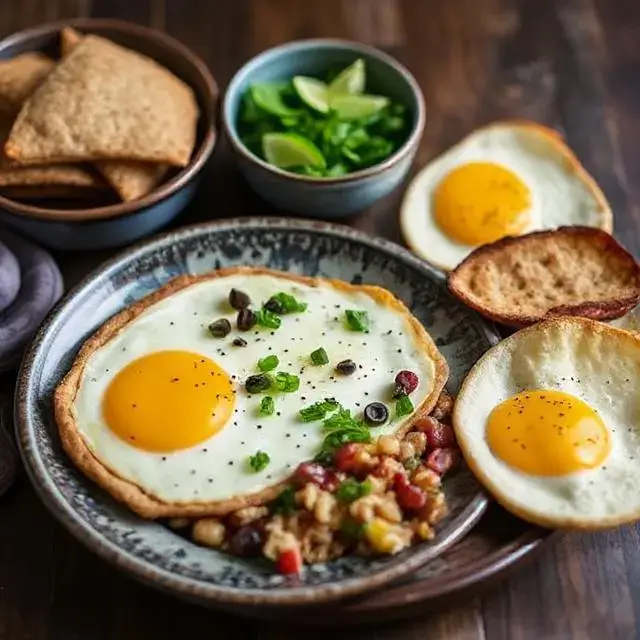middle eastern breakfast
Table of Contents

There’s something magical about a Middle Eastern breakfast that captivates all your senses. The intoxicating aroma of freshly baked flatbreads, the vibrant colors of mezze spreads dotting the table, and the harmonious blend of savory, tangy, and sweet flavors create an unforgettable morning experience. Whether you’re looking to explore traditional Middle Eastern breakfast dishes or searching for middle eastern breakfast near you, this comprehensive guide will take you on a culinary journey through one of the world’s most diverse and delicious breakfast traditions.
Middle Eastern breakfast isn’t a monolithic concept—it varies dramatically from Lebanon to Egypt, Turkey to Iran, and everywhere in between. Each region brings its own distinctive touch while sharing common threads that make these morning meals uniquely special. In this guide, we’ll explore over 20 authentic dishes, provide cultural context, and share recipes so you can create your own middle eastern breakfast spread at home.
Why Middle Eastern Breakfast Deserves Your Attention
What Makes a Breakfast “Middle Eastern”?
While diverse in execution, middle eastern breakfast typically revolves around several common elements:
- Fresh ingredients: Local, seasonal produce features prominently
- Savory focus: Unlike Western breakfasts, Middle Eastern morning meals often lean savory rather than sweet
- Core ingredients: Olive oil, tahini, legumes, fresh cheeses, herbs, and flatbreads create the foundation
- Communal style: Dishes are frequently served mezze-style for sharing
- Minimal processing: Foods are typically prepared simply to highlight natural flavors
The beauty of Middle Eastern breakfast lies in its balance—protein-rich components like eggs, beans, and dairy pair with complex carbohydrates from whole grains and fiber from fresh vegetables, creating nutritionally complete meals that sustain energy throughout the day.
Cultural Significance
In Middle Eastern culture, breakfast isn’t just about nourishment; it’s a social institution. Families gather around tables laden with multiple small dishes, sharing conversation and connection. Weekend breakfasts, in particular, often extend for hours, blurring the line between breakfast and lunch (similar to brunch). This communal approach to the first meal reflects the region’s emphasis on hospitality and family bonds.
Regional Variations
Middle Eastern breakfast traditions vary significantly across regions:
- Levantine region (Lebanon, Syria, Jordan, Palestine): Features mezze-style spreads with multiple small dishes including hummus, labneh, and za’atar manakish
- Egyptian breakfasts: Often center around ful medames and ta’ameya (falafel)
- Turkish morning meals: Showcase a variety of cheeses, olives, honey, and börek pastries
- Gulf countries: Incorporate more date-based dishes and specialized breads
- North African influences: Bring unique spice combinations and couscous-based morning dishes
Understanding these regional distinctions helps appreciate the rich tapestry of culinary traditions that make up what we broadly call “Middle Eastern breakfast.”
Middle Eastern Breakfast Dishes: A Comprehensive Guide
Ful Medames
Description: This hearty, protein-packed dish of stewed fava beans is considered by many to be the national breakfast of Egypt, though it’s popular throughout the Levant and beyond.
Main Ingredients:
- Dried fava beans
- Olive oil
- Lemon juice
- Garlic
- Cumin
- Fresh herbs (parsley, cilantro)
Origin/Region: While most strongly associated with Egypt, variations exist across the Middle East, with each country adding its unique twist.
Why It’s a Breakfast Staple: Nutrient-dense and filling, ful medames provides sustained energy and is economical, making it accessible to people from all walks of life.
Serving Suggestions: Traditionally served with soft pita bread, sliced hard-boiled eggs, fresh vegetables, tahini sauce, and a drizzle of olive oil. Often topped with diced tomatoes, onions, and fresh herbs.
Recipe Summary: Soak dried fava beans overnight, then simmer with water until soft (2-3 hours) or use canned beans for convenience. Mash slightly while keeping some texture, then season with crushed garlic, lemon juice, cumin, salt, and olive oil. Garnish with chopped parsley, diced tomatoes, and a drizzle of good olive oil.
Shakshuka
Description: Perhaps the most internationally recognized Middle Eastern breakfast dish, shakshuka features eggs poached in a spiced tomato and pepper sauce until the whites are set but yolks remain runny.
Main Ingredients:
- Eggs
- Tomatoes
- Bell peppers
- Onions
- Garlic
- Cumin, paprika
- Harissa or chili (optional for heat)
Origin/Region: Believed to have originated in Tunisia or Yemen before becoming widely popular throughout North Africa and the Middle East, particularly in Israel where it gained international recognition.
Why It’s a Breakfast Staple: Quick to prepare once the sauce is made (which can be prepared ahead), visually stunning, and endlessly adaptable.
Serving Suggestions: Served directly from the cooking pan with fresh bread for dipping. Often topped with crumbled feta cheese, fresh herbs, and a side of olives.
Recipe Summary: Sauté diced onions and bell peppers until soft, add minced garlic and spices, then pour in crushed tomatoes. Simmer until slightly reduced, make wells in the sauce, and crack eggs directly into them. Cover and cook until eggs reach desired doneness. Garnish with fresh herbs and serve hot.
Manakish (Za’atar Flatbread)
Description: A Levantine flatbread topped most commonly with za’atar (a thyme, sumac, and sesame seed mix), though cheese, minced meat, or other toppings may be used.
Main Ingredients:
- Bread dough (flour, water, yeast)
- Za’atar spice blend
- Olive oil
Origin/Region: Lebanon, Syria, Palestine, and Jordan are particularly known for their exceptional manakish.
Why It’s a Breakfast Staple: Quick to eat, portable, and often purchased from neighborhood bakeries where the dough is freshly prepared each morning.
Serving Suggestions: Typically folded or rolled and eaten with fresh vegetables, olives, or yogurt. Sometimes accompanied by fresh mint tea.
Recipe Summary: Prepare a simple dough with flour, water, yeast, and salt. After rising, flatten into discs and create dimples with fingertips. Mix za’atar with olive oil to form a paste and spread generously on dough. Bake in a hot oven (475°F/245°C) for 8-10 minutes until golden brown.
Labneh
Description: A thick, creamy strained yogurt cheese with a tangy flavor that serves as both a spread and a dip.
Main Ingredients:
- Full-fat yogurt
- Salt
- Olive oil (for serving)
Origin/Region: Common throughout the Levant and beyond.
Why It’s a Breakfast Staple: High in protein, simple to prepare ahead, and versatile as both a spread and a dip.
Serving Suggestions: Served drizzled with olive oil, often sprinkled with za’atar or dried mint. Used as a spread on bread or as a dip for vegetables.
Recipe Summary: Mix plain full-fat yogurt with salt, then strain through cheesecloth for 12-24 hours in the refrigerator until it reaches desired thickness. Serve in a shallow bowl with a “well” for olive oil, and garnish with herbs or spices.
Hummus
Description: While known globally as an appetizer or snack, this creamy chickpea and tahini dip is a common breakfast food throughout the Middle East.
Main Ingredients:
- Chickpeas
- Tahini
- Lemon juice
- Garlic
- Olive oil
Origin/Region: Ancient dish with contentious origins, claimed by multiple countries including Lebanon, Palestine, and Egypt.
Why It’s a Breakfast Staple: Protein-rich, satisfying, and pairs perfectly with other morning staples like flatbread and vegetables.
Serving Suggestions: Traditionally served room temperature with a drizzle of olive oil and perhaps a sprinkle of paprika or cumin. Accompanied by warm pita bread, fresh vegetables, or as part of a larger mezze spread.
Recipe Summary: Cook chickpeas until very soft, then blend with tahini, lemon juice, garlic, and salt until smooth and creamy. Transfer to a serving dish, create a shallow well in the center, and fill with good-quality olive oil.
Foul Mudammas (Alternative Spelling of Ful Medames)
Description: This variation of fava bean stew differs slightly from region to region, with some versions including chickpeas or tomatoes.
Main Ingredients:
- Fava beans
- Chickpeas (optional)
- Tomatoes (optional)
- Lemon juice
- Garlic
- Olive oil
Origin/Region: Particularly popular in Sudan, Saudi Arabia, and Yemen with regional variations.
Why It’s a Breakfast Staple: Hearty, economical, and can be prepared in large batches.
Serving Suggestions: Similar to ful medames, served with flatbread, vegetables, and optional toppings like boiled eggs, tahini sauce, or fresh herbs.
Recipe Summary: Similar to ful medames but often incorporates additional ingredients like chickpeas or tomatoes depending on the regional variation.
Fattet Hummus
Description: A layered dish combining chickpeas, toasted bread, yogurt sauce, and toppings for a luxurious breakfast experience.
Main Ingredients:
- Chickpeas
- Toasted pita bread
- Garlic yogurt sauce
- Pine nuts
- Olive oil
Origin/Region: Popular in Syria, Lebanon, and Palestine.
Why It’s a Breakfast Staple: Offers a perfect balance of textures—crispy bread, creamy yogurt, tender chickpeas—and can be prepared ahead.
Serving Suggestions: Served in individual bowls or as a centerpiece dish for sharing.
Recipe Summary: Layer toasted, broken pita bread in a dish, top with warm chickpeas, then cover with a garlicky yogurt sauce. Garnish with toasted pine nuts, paprika, cumin, and a generous drizzle of olive oil. Served immediately to maintain the contrast between crisp and soft textures.
Msabbaha
Description: A close relative of hummus but with whole or partially mashed chickpeas for textural contrast.
Main Ingredients:
- Chickpeas (whole or partially mashed)
- Tahini
- Lemon juice
- Garlic
- Olive oil
- Cumin
Origin/Region: Popular in Palestinian, Lebanese, and Syrian cuisine.
Why It’s a Breakfast Staple: More textured than hummus, making it substantial and satisfying.
Serving Suggestions: Served at room temperature with flatbread, pickles, and raw onions.
Recipe Summary: Cook chickpeas until soft, then roughly mash some while leaving others whole. Mix with tahini sauce (tahini, lemon juice, garlic) and season with cumin, salt, and pepper. Serve with a generous amount of olive oil and chopped herbs.
Shakshouka Variations
Green Shakshouka
Description: A verdant twist on the classic, using leafy greens instead of tomatoes as the base.
Main Ingredients:
- Eggs
- Spinach, Swiss chard, or kale
- Leeks or onions
- Herbs (cilantro, parsley, dill)
- Feta cheese (optional)
Origin/Region: Popular in Israel and parts of the Levant.
Why It’s a Breakfast Staple: Offers a lighter alternative to traditional shakshuka while still being nutritionally complete.
Serving Suggestions: Similar to red shakshuka, served straight from the pan with bread for dipping.
Recipe Summary: Sauté chopped leeks or onions until soft, add minced garlic and spices, then mix in chopped leafy greens until wilted. Create wells for eggs, crack them in, and cook until whites are set but yolks remain runny. Garnish with herbs and crumbled feta if desired.
Turkish Menemen
Description: A Turkish egg dish similar to shakshuka but with scrambled eggs incorporated throughout the tomato and pepper mixture rather than poached on top.
Main Ingredients:
- Eggs
- Tomatoes
- Green peppers
- Onions
- Turkish pepper flakes (pul biber)
Origin/Region: Turkey, particularly popular in rural areas.
Why It’s a Breakfast Staple: Quick to prepare and adaptable based on available seasonal ingredients.
Serving Suggestions: Served hot with crusty bread and accompanied by black olives, cucumbers, and cheese.
Recipe Summary: Sauté diced onions and peppers until soft, add chopped tomatoes and spices and cook until slightly reduced. Beat eggs lightly, pour over the mixture, and stir occasionally until eggs are just set but still moist. Sprinkle with herbs before serving.
Balila
Description: A warm chickpea dish simpler than hummus, highlighting the natural flavor of chickpeas with lemon, garlic, and olive oil.
Main Ingredients:
- Chickpeas
- Lemon juice
- Garlic
- Cumin
- Olive oil
Origin/Region: Lebanon and Syria.
Why It’s a Breakfast Staple: Simple to prepare and offers a lighter alternative to more complex breakfast dishes.
Serving Suggestions: Served warm with a side of fresh vegetables, olives, and bread.
Recipe Summary: Warm cooked chickpeas with their cooking liquid, then season with crushed garlic, lemon juice, cumin, and salt. Serve in bowls topped with a generous glug of olive oil and chopped parsley.
Fatteh
Description: A layered dish combining toasted bread, chickpeas or eggplant, yogurt sauce, and toppings for a luxurious breakfast experience.
Main Ingredients:
- Toasted pita bread
- Chickpeas or eggplant
- Tahini-yogurt sauce
- Pine nuts
- Pomegranate seeds (optional)
Origin/Region: Popular across the Levant with regional variations.
Why It’s a Breakfast Staple: The combination of crispy, creamy, and chewy textures makes for a satisfying morning meal.
Serving Suggestions: Served immediately after assembly to maintain textural contrast, often as a weekend or special occasion breakfast.
Recipe Summary: Layer toasted pita pieces at the bottom of a dish, top with warm chickpeas or roasted eggplant, then pour over a mixture of yogurt, tahini, lemon juice, and garlic. Garnish with toasted pine nuts, pomegranate seeds (when in season), chopped herbs, and a drizzle of olive oil.
Bayd wa Tomat (Eggs with Tomatoes)
Description: A simple yet flavorful dish of eggs poached or scrambled with sautéed tomatoes, onions, and peppers.
Main Ingredients:
- Eggs
- Tomatoes
- Onions
- Bell peppers (optional)
- Cumin, paprika
Origin/Region: Common throughout the Middle East with minor variations.
Why It’s a Breakfast Staple: Quick to prepare with commonly available ingredients and adaptable based on seasonal produce.
Serving Suggestions: Served hot with bread for scooping and a side of olives or cheese.
Recipe Summary: Sauté diced onions until translucent, add chopped tomatoes and peppers, and cook until softened. Either scramble eggs directly into the mixture or create wells to poach them. Season with cumin, paprika, salt, and pepper.
Sujouk with Eggs
Description: Spicy Armenian sausage cooked with eggs for a protein-rich breakfast with bold flavors.
Main Ingredients:
- Sujouk (spiced beef sausage)
- Eggs
- Tomatoes (optional)
- Peppers (optional)
Origin/Region: Popular in Lebanon, Syria, Armenia, and Turkey.
Why It’s a Breakfast Staple: The combination of spiced meat and eggs provides substantial protein to start the day.
Serving Suggestions: Served hot with fresh bread and accompanied by vegetables or a simple salad.
Recipe Summary: Slice sujouk and cook briefly in a hot pan until it releases its oils and begins to crisp. Add beaten eggs or crack whole eggs into the pan and cook to desired doneness. Season with black pepper and serve hot.
Halawa/Halva
Description: A sweet tahini-based confection often enjoyed as part of a Middle Eastern breakfast spread for those with a sweet tooth.
Main Ingredients:
- Tahini
- Sugar or honey
- Nuts (pistachios, almonds)
- Flavorings (vanilla, chocolate, etc.)
Origin/Region: Common throughout the Middle East with variations across regions.
Why It’s a Breakfast Staple: Provides a sweet component to balance the predominantly savory breakfast spread.
Serving Suggestions: Sliced thinly and eaten with bread, often accompanied by tea. Sometimes crumbled over yogurt.
Recipe Summary: While traditionally complex to make at home, store-bought halva can be served sliced thin or crumbled. Homemade versions involve cooking sugar to the thread stage, then incorporating it into tahini with continuous stirring until the mixture thickens and pulls away from the sides of the pot.
Makhlama (Iraqi Eggs with Meat)
Description: A hearty breakfast dish of scrambled eggs with spiced ground meat, tomatoes, and onions.
Main Ingredients:
- Eggs
- Ground lamb or beef
- Tomatoes
- Onions
- Turmeric, cumin, coriander
Origin/Region: Iraq.
Why It’s a Breakfast Staple: Provides substantial protein and is filling enough to power through a physically demanding day.
Serving Suggestions: Served hot with fresh flatbread and a side of vegetables or pickles.
Recipe Summary: Brown seasoned ground meat with onions, add diced tomatoes and cook until softened, then pour in beaten eggs and cook until just set, stirring occasionally. Season with cumin, turmeric, and fresh herbs.
Mohammara
Description: A rich, spicy dip made from roasted red peppers, walnuts, and pomegranate molasses.
Main Ingredients:
- Roasted red peppers
- Walnuts
- Breadcrumbs
- Pomegranate molasses
- Aleppo pepper
Origin/Region: Originated in Aleppo, Syria but popular throughout the Levant.
Why It’s a Breakfast Staple: Adds a spicy-sweet component to the breakfast spread.
Serving Suggestions: Served as part of a mezze spread with bread for dipping.
Recipe Summary: Blend roasted red peppers with toasted walnuts, breadcrumbs, Aleppo pepper, and pomegranate molasses until smooth but retaining some texture. Season with salt and serve drizzled with olive oil.
Date Molasses with Tahini (Dibis w’rashi)
Description: A simple yet delicious sweet spread combining the deep sweetness of date molasses with nutty tahini.
Main Ingredients:
- Date molasses (dibis)
- Tahini
- Bread for dipping
Origin/Region: Popular in Palestine, Jordan, Lebanon, and Iraq.
Why It’s a Breakfast Staple: Quick to prepare and offers natural sweetness from dates.
Serving Suggestions: Served in separate dishes for diners to combine on their plate or bread as desired.
Recipe Summary: Simply serve good quality date molasses alongside tahini, either mixed together or separately for diners to combine themselves, typically spread on bread.
Kaak (Sesame Bread Rings)
Description: Ring-shaped bread coated with sesame seeds, either soft or crisp depending on the region.
Main Ingredients:
- Flour
- Yeast
- Sesame seeds
- Mahlab (optional)
- Anise (optional)
Origin/Region: Popular across the Levant with variations in each country.
Why It’s a Breakfast Staple: Portable, keeps well, and pairs with everything from cheese to za’atar.
Serving Suggestions: Served with cheese, za’atar, or simply dipped in tea.
Recipe Summary: Prepare a yeasted dough with flour, water, yeast, and optional flavorings. After rising, shape into rings, dip in sesame seeds, and bake until golden. Can be soft (like bagels) or crunchy (like oversized pretzels) depending on the recipe.
Qalayet Bandora (Sautéed Tomatoes)
Description: A simple yet flavorful dish of tomatoes sautéed with olive oil, garlic, and spices.
Main Ingredients:
- Tomatoes
- Olive oil
- Garlic
- Fresh herbs (parsley, mint)
Origin/Region: Jordan and Palestine.
Why It’s a Breakfast Staple: Quick to prepare and makes excellent use of seasonal tomatoes.
Serving Suggestions: Served hot with fresh bread for dipping, often accompanied by fried or boiled eggs.
Recipe Summary: Sauté diced tomatoes in olive oil with minced garlic until softened and slightly reduced. Season with salt and pepper and finish with chopped fresh herbs.
Shorbat Adas (Lentil Soup)
Description: A hearty red lentil soup sometimes enjoyed for breakfast, particularly in cooler weather.
Main Ingredients:
- Red lentils
- Onions
- Carrots
- Cumin, coriander
- Lemon juice
Origin/Region: Common throughout the Middle East.
Why It’s a Breakfast Staple: Warming, filling, and nutritious, especially in winter months.
Serving Suggestions: Served hot with lemon wedges and croutons or crispy bread.
Recipe Summary: Sauté onions and carrots, add red lentils and water or stock, simmer until lentils disintegrate, then season with cumin, coriander, and lemon juice. Blend for a smooth consistency if desired.
Beyond the Dishes: Essential Accompaniments
A true middle eastern breakfast spread is incomplete without these essential accompaniments:
Breads
Middle Eastern breakfasts almost always include some form of bread for dipping, scooping, or spreading:
- Khubz/Pita: Soft flatbread with a pocket
- Taboon: Thicker flatbread baked in a clay oven
- Lavash: Thin, soft flatbread popular in Armenia and Turkey
- Markook/Shrak: Paper-thin bread made on a domed griddle
- Kaak: Sesame bread rings (mentioned above)
Cheeses
Fresh dairy features prominently in Middle Eastern breakfasts:
- Halloumi: Semi-hard, brined cheese often served grilled
- Feta: Crumbly, brined cheese
- Nabulsi: Firm, brined cheese from Palestine, sometimes flavored with mahlab
- Akkawi: Mildly flavored cheese similar to mozzarella
- Labneh balls: Strained yogurt formed into balls and preserved in olive oil, often with herbs or spices
Olives & Pickles
These provide acidic contrast to richer dishes:
- Olives: Various types and preparations including green, black, oil-cured, and spiced
- Turshi: Assorted pickled vegetables including cucumbers, turnips, cauliflower, and carrots
- Pickled labneh: Yogurt cheese preserved with olive oil and herbs
- Makdous: Baby eggplants stuffed with walnuts and red pepper, preserved in olive oil
Dips & Spreads (beyond Hummus/Labneh)
- Muhammara: Roasted red pepper and walnut dip
- Baba Ghanoush: Smoky eggplant dip
- Tahini sauce: Sesame paste thinned with lemon and water
- Za’atar mix with oil: Thyme-based herb blend mixed with olive oil for bread dipping
Herbs & Vegetables
Fresh produce adds color, nutrients, and crunch:
- Fresh mint, parsley, cilantro: Served in bunches to be eaten as is
- Cucumber and tomato: Often served sliced or diced
- Radishes: Provide peppery crunch
- Green onions: Added for sharp flavor
- Fresh greens: Purslane, arugula, or watercress according to season
Sweet Touches
To balance the predominantly savory spread:
- Honey: Drizzled over labneh or cheese
- Date Syrup (Dibis): Used similarly to honey
- Halawa/Halva: Tahini-based confection
- Fresh fruits: Seasonal options like figs, dates, or pomegranate
- Jams: Often homemade from fruits like apricot, fig, or strawberry
Drinks
No Middle Eastern breakfast is complete without beverages:
- Black Tea: Often brewed strong with mint or sage
- Arabic Coffee: Cardamom-spiced and served in small cups
- Turkish Coffee: Unfiltered, strong coffee with cardamom
- Mint Tea: Fresh mint leaves steeped in hot water
How to Create Your Own Middle Eastern Breakfast Spread
Creating your own middle eastern breakfast spread at home might seem daunting, but it’s actually quite approachable with these practical tips:
Start Simple
Begin with just 3-4 elements:
- A simple dip like hummus or labneh
- Good quality bread
- Olives or pickles
- Fresh vegetables
Suggested Combinations
A Levantine Quick Bite
- Labneh drizzled with olive oil and za’atar
- Sliced cucumbers and tomatoes
- Olives
- Pita bread
- Mint tea
A Hearty Egyptian Breakfast
- Ful medames
- Boiled eggs
- Feta cheese
- Baladi bread
- Fresh herbs
Turkish Morning Delight
- Menemen (Turkish scrambled eggs with tomatoes)
- White cheese (feta or beyaz peynir)
- Black olives
- Cucumbers
- Simit (Turkish sesame bread rings)
Make-Ahead Components
Several Middle Eastern breakfast components can be prepared in advance:
- Labneh: Strain yogurt 24 hours before
- Hummus and dips: Prepare 1-2 days ahead and refrigerate
- Ful medames: Prepare the base and reheat with final seasonings in the morning
- Pickled vegetables: Make a week in advance
- Bread dough: Prepare the night before and bake fresh in the morning
Presentation Tips
The visual aspect of a middle eastern breakfast spread is almost as important as the taste:
- Use small, shallow dishes for dips and spreads
- Arrange items by color for visual appeal
- Include height variation with bread baskets or stacked plates
- Drizzle olive oil just before serving for a fresh sheen
- Sprinkle dishes with colorful garnishes like pomegranate seeds, sumac, or fresh herbs
Frequently Asked Questions about Middle Eastern Breakfast
What is a typical Middle Eastern breakfast?
A typical Middle Eastern breakfast consists of multiple small dishes served together, often including bread, cheese, olives, eggs prepared in various ways, beans like ful medames, dips such as hummus and labneh, fresh vegetables, and herbs. The emphasis is on variety, freshness, and sharing, with both savory and sweet elements. Unlike Western breakfasts, Middle Eastern morning meals are rarely centered around sweet items.
Is Middle Eastern breakfast healthy?
Yes, traditional Middle Eastern breakfast tends to be very healthy as it emphasizes whole foods, vegetables, legumes, olive oil, and lean proteins. The mezze-style of eating encourages portion control and variety, providing a balanced mix of macronutrients and micronutrients. Many components are high in fiber, healthy fats, and plant-based proteins, while being relatively low in refined sugars. The Mediterranean diet, which shares many elements with Middle Eastern cuisine, is consistently ranked among the healthiest diets globally.
What do Arabs eat for breakfast?
This question encompasses diverse culinary traditions, as “Arab” refers to people from 22 countries with distinct regional specialties. Arab breakfasts vary widely across regions but generally include flatbreads, cheese, olives, eggs, beans (particularly ful medames in Egypt and the Levant), yogurt products like labneh, and various dips and spreads. Morning meals are often communal affairs with multiple shared dishes. Gulf Arab countries might include more date-based dishes, while North African Arab countries might incorporate different spice profiles and couscous.
What is the most popular Middle Eastern breakfast dish?
Ful medames (stewed fava beans) and variations of egg dishes like shakshuka are among the most universally popular breakfast items across the Middle East. Hummus, though not exclusively a breakfast food in Western perceptions, is commonly eaten in the morning throughout the region. The popularity of specific dishes varies by country—manakish is beloved in Lebanon, while Turkish menemen is a staple in Turkey.
Can I make Middle Eastern breakfast vegetarian/vegan?
Middle Eastern breakfast is exceptionally vegetarian and vegan-friendly. Many traditional dishes are naturally plant-based, including ful medames, hummus, fattet hummus (without yogurt), muhammara, and various bread and vegetable offerings. For vegetarians, the dairy components like labneh and cheese add protein variety. For vegans, tahini and legume-based dishes provide plenty of protein, making it simple to enjoy a satisfying, authentic plant-based Middle Eastern breakfast. Simply omit the yogurt-based components or substitute plant-based yogurt alternatives.
Conclusion
The rich tapestry of Middle Eastern breakfast traditions offers something for everyone—from the protein-packed simplicity of ful medames to the aromatic complexity of za’atar manakish. As we’ve explored these 20+ authentic dishes, it becomes clear that Middle Eastern breakfast isn’t just about nourishment; it’s about connection, hospitality, and celebration of fresh, flavorful ingredients.
What makes these breakfast traditions truly special is their adaptability—you can create an elaborate spread for weekend gatherings or select just a few elements for a quick weekday morning meal. The emphasis on fresh ingredients, balanced nutrition, and vibrant flavors makes Middle Eastern breakfast not just delicious but a sustainable, healthy way to start your day.
Whether you’re looking for middle eastern breakfast near you at a local restaurant or ready to create your own middle eastern breakfast spread at home, the dishes we’ve explored provide a roadmap to this wonderful culinary tradition. Begin with simpler components like labneh or hummus, add good bread and fresh vegetables, and gradually expand your repertoire to include more complex dishes like shakshuka or manakish.
What’s your favorite Middle Eastern breakfast dish? Have you tried creating a mezze-style breakfast at home? Share your experiences in the comments below, or tag us in your breakfast creations on social media!
Share Your Creation!
I’d love to see how your middle eastern breakfast turns out! If you make this recipe, please leave a comment and rating below. You can also share your creation by tagging me on pinterest @bake_iteasy with the hashtag #cmiddle eastern breakfast.
Did you try our recipe ?
There are no reviews yet. Be the first one to write one.







